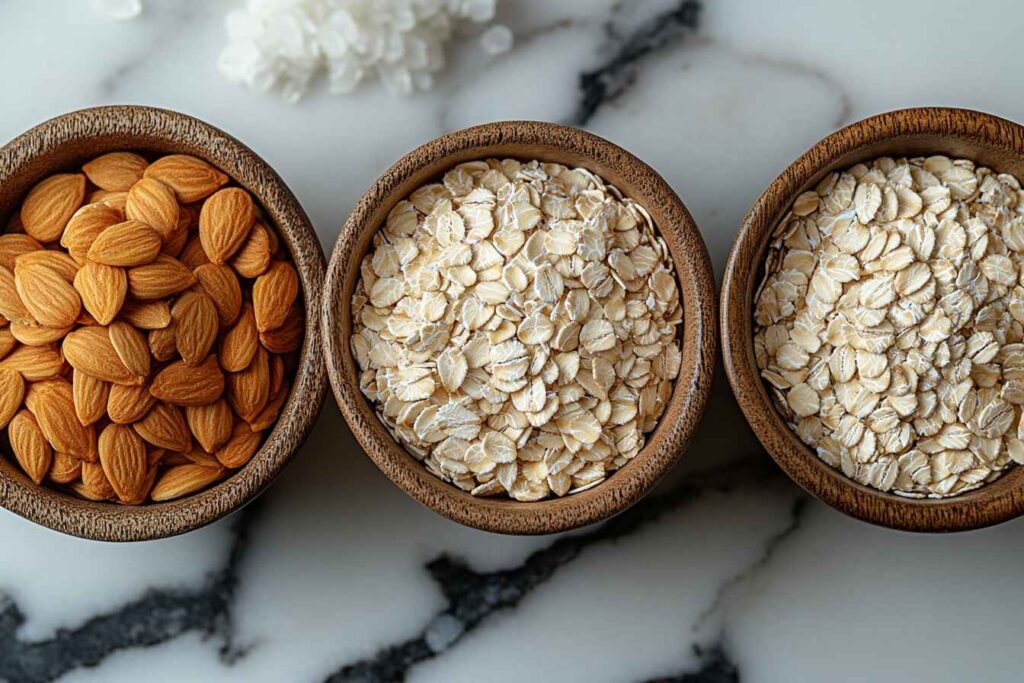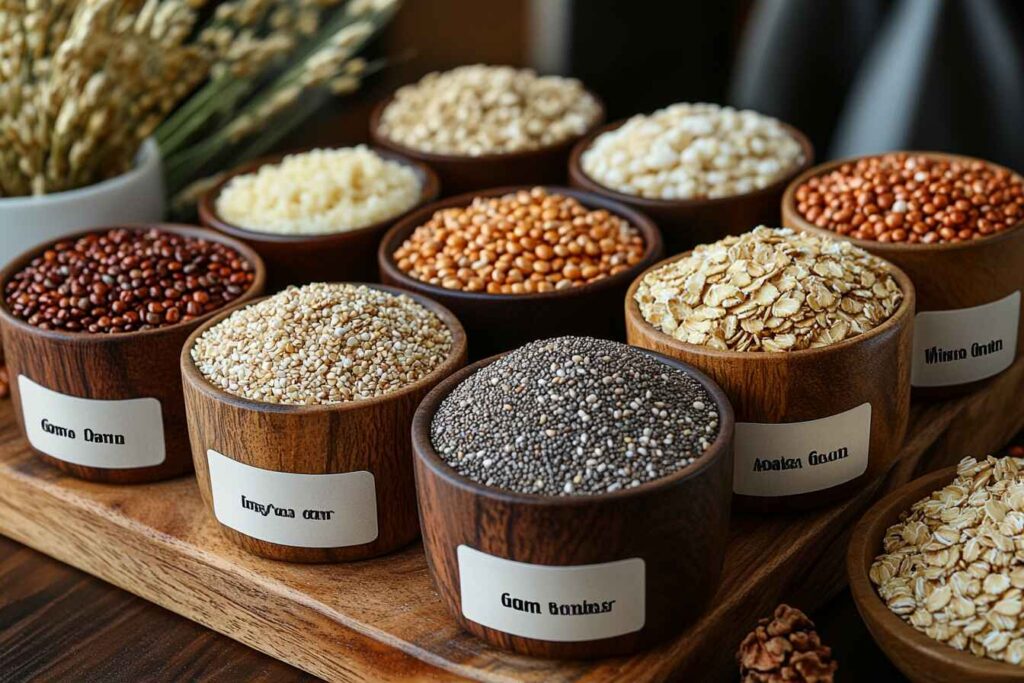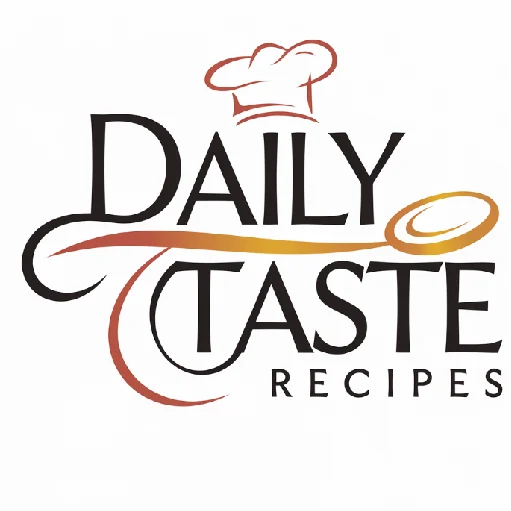Oatmeal is a staple breakfast for millions worldwide. It’s warm, filling, and packed with nutrients. But if you’re on a gluten-free or dairy-free diet, you might be wondering: Can I eat oatmeal safely?
Oats themselves seem harmless. They’re whole grains, right? But things get tricky when you factor in cross-contamination, processing, and added ingredients. Let’s break it all down step by step so you can enjoy your bowl of oatmeal worry-free.
Understanding Oatmeal: What Is It?
The Basics of Oatmeal: How It’s Made
Oatmeal comes from whole oat grains (also called oat groats), which are processed into different forms. The most common types include:
- Steel-Cut Oats – The least processed, chopped into small pieces. Takes longer to cook.
- Rolled Oats – Steamed and flattened, making them softer and quicker to cook.
- Instant Oats – Pre-cooked, dried, and finely cut for quick preparation.
Despite their differences in texture and cooking time, all oats start gluten-free. But that doesn’t mean they stay that way.
Nutritional Benefits of Oatmeal
Oatmeal isn’t just a comforting breakfast—it’s packed with nutrients! Here’s a quick look at what you’re getting in a typical serving:
Oatmeal Nutrition Facts (Per 1/2 Cup Dry Oats)
Nutrient Amount Calories 150 Carbohydrates 27g Protein 5g Fiber 4g Fat 3g
Oatmeal is also rich in:
- Beta-glucan fiber – Helps lower cholesterol and improve gut health.
- Iron and magnesium – Essential for energy production and muscle function.
- Antioxidants – Reduce inflammation and support overall health.
But while it’s a powerhouse of nutrients, its gluten-free status depends on how it’s grown and processed.

Is Oatmeal Naturally Gluten-Free?
What is Gluten, and Why Does It Matter?
Gluten is a protein found in wheat, barley, and rye. It gives dough its elasticity and helps baked goods maintain their shape. But for people with celiac disease or gluten sensitivity, even small amounts can trigger severe reactions.
Are Oats Naturally Gluten-Free?
Yes! Oats don’t contain gluten naturally. They belong to a different plant family than wheat, rye, and barley. But there’s a big catch—cross-contamination.
The Risk of Cross-Contamination in Oats
Most oats are grown and processed near wheat fields or in facilities that handle gluten-containing grains. This means they can easily pick up traces of gluten. For someone with celiac disease, even tiny amounts of contamination can cause digestive distress, fatigue, and long-term damage to the intestines.
How to Identify Certified Gluten-Free Oats
If you need truly gluten-free oats, look for labels that say:
- “Certified Gluten-Free” – This ensures they were processed in a dedicated gluten-free facility.
- “Purity Protocol Oats” – These are oats grown in fields free from cross-contamination.
Top Certified Gluten-Free Oat Brands
- Bob’s Red Mill Gluten-Free Oats
- Nature’s Path Organic Gluten-Free Oats
- Quaker Gluten-Free Oats
- GF Harvest Certified Gluten-Free Oats
Always check the packaging carefully because even brands that sell regular oats may also offer gluten-free options.
Is Oatmeal Dairy-Free?
Understanding Dairy and Its Role in Breakfast Foods
Dairy comes from animal milk (cow, goat, or sheep) and includes products like cheese, yogurt, and butter. Some people avoid dairy due to lactose intolerance, milk allergies, or dietary choices (like veganism).
Is Plain Oatmeal Dairy-Free?
Yes! Plain, unflavored oats contain no dairy. The problem arises when you add milk or use pre-packaged flavored oatmeal, which may include dairy-derived ingredients like:
- Milk powder – Used to add creaminess.
- Whey protein – A dairy-based protein often found in flavored oatmeal.
- Butter flavor – Some instant oatmeals use butter flavoring, which may contain dairy.
When Oatmeal Becomes Non-Dairy Friendly
If you’re buying instant oatmeal, always check the ingredients list. Some flavors—like maple & brown sugar or strawberries & cream—may include dairy.
Common Instant Oatmeal Ingredients That May Contain Dairy
- Nonfat dry milk
- Whey protein concentrate
- Butterfat
- Casein (milk protein)
The best way to keep oatmeal dairy-free? Make it yourself with water or non-dairy milk (like almond, coconut, or oat milk).
Common Problems: Why Some People React to Oatmeal
Even if you buy certified gluten-free and dairy-free oatmeal, some people still experience digestive issues, bloating, or discomfort after eating it. Why does this happen? Let’s look at the most common problems.
Cross-Contamination with Gluten
One of the biggest culprits is hidden gluten. Even if oats are naturally gluten-free, they can pick up traces of gluten during:
- Growing near wheat, barley, or rye fields.
- Being processed in facilities that handle gluten-containing grains.
- Transportation and packaging.
This is why people with celiac disease should only buy certified gluten-free oats. Without this label, even a small amount of contamination could cause a reaction.
Oats and Avenin Sensitivity: Gluten-Free but Still Problematic?
Here’s something surprising—some people react to oats even if they’re 100% gluten-free. That’s because oats contain a protein called avenin, which is similar to gluten.
While most people tolerate avenin just fine, a small percentage of those with celiac disease or gluten sensitivity still experience symptoms like:
- Digestive issues (bloating, gas, diarrhea).
- Fatigue and brain fog.
- Skin reactions.
If you react to gluten-free oats, your body might be sensitive to avenin. The only way to know for sure? Try eliminating oats for a few weeks and see if your symptoms improve.
Dairy Additions in Instant or Pre-Made Oatmeal
Another common problem? Hidden dairy ingredients in instant oatmeal packets. Many store-bought oatmeals include:
- Milk powder – Added for a creamy texture.
- Whey protein – A byproduct of cheese-making.
- Butter flavor – Some flavored oatmeals sneak in dairy-based ingredients.
How to Spot Dairy in Packaged Oatmeal
Check the ingredient list for words like:
- Milk solids
- Casein
- Butterfat
- Nonfat dry milk
The safest bet? Make your own oatmeal from scratch using pure oats and non-dairy ingredients.
How to Choose the Best Gluten-Free, Dairy-Free Oatmeal
Not all oatmeal is created equal. If you’re following a gluten-free and dairy-free diet, here’s what to look for.
Best Brands Offering Certified Gluten-Free Oats
These brands sell certified gluten-free oats, meaning they’ve been tested to ensure no cross-contamination:
Top Gluten-Free Oat Brands
- Bob’s Red Mill Gluten-Free Oats – One of the most trusted brands.
- Nature’s Path Organic Gluten-Free Oats – Great for organic eaters.
- Quaker Gluten-Free Oats – A widely available option.
- GF Harvest Certified Gluten-Free Oats – Family-owned and dedicated to purity.
Tips for Buying Safe and Pure Oats
Before buying oats, check for:
- Certified Gluten-Free Label – Ensures no cross-contamination.
- Non-Dairy Ingredients – Avoid oats mixed with dairy-containing flavors.
- Minimal Processing – Less processing means a lower risk of contamination.
Checking Labels: Hidden Gluten and Dairy Ingredients
Gluten and dairy can hide under different names. When reading labels, watch out for:
Hidden Gluten Ingredients
- Malt extract
- Modified food starch (if unspecified)
- Hydrolyzed wheat protein
Hidden Dairy Ingredients
- Casein
- Whey protein
- Butter flavor
Making Your Own Gluten-Free, Dairy-Free Oatmeal at Home
The safest and healthiest way to enjoy oatmeal? Make it yourself! It’s easy, delicious, and lets you control exactly what goes in your bowl.
How to Prepare Oatmeal Safely for Gluten Sensitivities
Follow these steps for a foolproof gluten-free and dairy-free oatmeal:
- Choose certified gluten-free oats – The most important step!
- Use non-dairy milk – Almond, oat, coconut, or soy milk works well.
- Add natural sweeteners – Maple syrup, honey, or mashed banana.
- Enhance flavor with spices – Cinnamon, nutmeg, or vanilla extract.
Best Dairy-Free Milk Alternatives for Creamy Oatmeal
Want that rich, creamy texture without dairy? Try these plant-based options:
- Almond milk – Light and nutty.
- Coconut milk – Adds a tropical twist.
- Oat milk – Extra creamy and naturally sweet.
- Cashew milk – Smooth and rich.
Delicious Gluten-Free, Dairy-Free Oatmeal Recipes
Here are some easy, tasty ways to make oatmeal even better:
Recipe 1: Cinnamon Apple Oatmeal
Ingredients:
- 1/2 cup gluten-free oats
- 1 cup almond milk
- 1/2 apple, chopped
- 1/2 teaspoon cinnamon
- 1 teaspoon maple syrup
- 1 tablespoon chopped walnuts (optional)
Instructions:
- Heat almond milk in a pot and add oats.
- Stir in apples, cinnamon, and maple syrup.
- Cook for 5 minutes until thickened.
- Top with walnuts and enjoy!
Recipe 2: Chocolate Peanut Butter Oatmeal
Ingredients:
- 1/2 cup gluten-free oats
- 1 cup oat milk
- 1 tablespoon cocoa powder
- 1 tablespoon peanut butter
- 1 teaspoon honey
Instructions:
- Heat oat milk in a saucepan and stir in oats.
- Add cocoa powder and peanut butter.
- Cook for 5 minutes, stirring frequently.
- Drizzle with honey and serve warm.
Is Instant Oatmeal Safe for a Gluten-Free and Dairy-Free Diet?
If you’re always on the go, instant oatmeal is a lifesaver. Just add hot water or milk, stir, and it’s ready! But is it safe for gluten-free and dairy-free diets? Let’s break it down.
Understanding Instant Oatmeal Ingredients
Unlike regular oats, instant oatmeal often contains added flavors, sweeteners, and preservatives. Some brands also include milk-derived ingredients or use oats that may be contaminated with gluten.
Common Problematic Ingredients in Instant Oatmeal
- Milk Powder – Used to add creaminess.
- Malt Extract – Contains gluten.
- Artificial Flavors – Some may contain hidden gluten or dairy.
- Thickeners & Stabilizers – Often derived from wheat or dairy.
To stay safe, always check the label for a Certified Gluten-Free and Dairy-Free seal.
Popular Instant Oatmeal Brands: Are They Safe?
Many brands offer gluten-free and dairy-free instant oatmeal options. Here are some of the best choices:
Top Gluten-Free, Dairy-Free Instant Oatmeal Brands
- Purely Elizabeth Superfood Oats – Made with certified gluten-free oats and dairy-free ingredients.
- Bob’s Red Mill Gluten-Free Oatmeal Cups – Convenient and free from dairy.
- Nature’s Path Qi’a Superfood Oatmeal – Organic, vegan, and gluten-free.
- Bakery on Main Instant Oatmeal – Certified gluten-free and dairy-free.
Best Gluten-Free, Dairy-Free Instant Oatmeal Options
If you can’t find a safe pre-packaged instant oatmeal, make your own! Here’s a quick and easy DIY recipe.
DIY Instant Oatmeal Recipe (Gluten-Free & Dairy-Free)
Ingredients:
- 1 cup gluten-free oats (blended into a coarse powder)
- 1 tablespoon chia seeds
- 1 teaspoon cinnamon
- 2 teaspoons coconut sugar or maple sugar
- 1/2 teaspoon vanilla powder (optional)
Instructions:
- Mix all ingredients in a jar.
- When ready to eat, add 1/2 cup hot water or dairy-free milk.
- Stir well and let it sit for 2-3 minutes.
- Top with fruit, nuts, or seeds for extra flavor!
Can You Eat Oatmeal on a Strict Gluten-Free and Dairy-Free Diet?
Now that we’ve covered all the details, let’s answer the big question: Should you eat oatmeal if you’re on a gluten-free and dairy-free diet?
Who Should Avoid Oatmeal?
While most people can enjoy oatmeal safely, some may need to avoid it, including:
- People with celiac disease who react to even certified gluten-free oats.
- Individuals with oat allergies.
- Those sensitive to avenin (the protein in oats similar to gluten).
If you experience discomfort after eating oatmeal, it might be worth trying an elimination diet to see if oats are the culprit.
Substitutes for Oatmeal in a Gluten-Free and Dairy-Free Diet
If you need an alternative, try these nutritious and filling oatmeal substitutes:
Best Oatmeal Alternatives
- Quinoa Flakes – High in protein and naturally gluten-free.
- Chia Seed Pudding – Packed with fiber and omega-3s.
- Buckwheat Groats – Despite the name, it’s completely gluten-free!
- Rice Porridge – Made with brown or white rice for a comforting bowl.
- Millet Porridge – A mild, nutty-flavored grain that works well as a breakfast base.
Each of these options provides a similar texture and nutritional profile to oatmeal, making them excellent swaps.

Final Thoughts: Should You Eat Oatmeal on a Gluten-Free and Dairy-Free Diet?
Oatmeal is an amazing breakfast option, but only if you choose the right kind. If you’re gluten-sensitive or avoiding dairy, follow these key takeaways:
Key Takeaways
- Oats are naturally gluten-free, but cross-contamination is a real risk.
- Choose certified gluten-free oats to avoid gluten exposure.
- Plain oats are dairy-free, but flavored instant oatmeal may contain dairy.
- Check labels carefully for hidden gluten and dairy ingredients.
- If you react to gluten-free oats, you might have an avenin sensitivity.
- Making your own oatmeal at home ensures complete control over ingredients.
Safe Consumption Tips for Sensitive Individuals
To enjoy oatmeal worry-free, follow these tips:
- Buy from trusted brands with gluten-free certification.
- Avoid flavored oatmeals unless they’re labeled dairy-free.
- Consider making DIY oatmeal mixes to control ingredients.
- Listen to your body—if oatmeal causes issues, try an alternative.
At the end of the day, oatmeal can be a nutritious, delicious, and safe breakfast—as long as you choose wisely. Enjoy your warm, hearty bowl with confidence!

